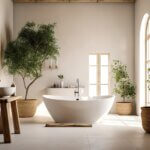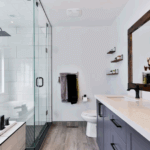Best Materials for Durable and Stylish Bathroom Vanities
Bathrooms create unique conditions that can significantly damage unsuitable materials, potentially leading to expensive repairs down the road. Choosing the right materials will ensure that your bathroom vanity not only looks beautiful but can also withstand humidity and constant use. This guide will walk you through effective materials for vanity cabinets and countertops to help you make the right decision for your next bathroom project.
Understanding the Importance of Material Selection
Bathroom vanities endure harsh environments. Steamy showers create dampness, while temperature fluctuations cause materials to expand and contract. When using the wrong materials, water and cleaning products can cause significant damage. Wood presents a particular challenge; it's porous and easily absorbs moisture, causing warping, swelling, rot, mold, and structural weakness. Well-sealed solid wood cabinets can last 15 to 20 years with proper maintenance.
Best Bathroom Cabinet Materials
You have a wide range of options at different price points, from budget-friendly medium-density fiberboard (MDF) to high-end solid wood that costs more but lasts decades with proper care. Using quality materials also increases the value of your home. Whether you're a contractor looking for specifications or a DIY enthusiast doing research, each material has specific strengths for different budgets and bathroom conditions.
Solid Wood
Solid wood delivers natural beauty and durability. Oak, maple, cherry, walnut, hickory, and birch offer unique grains and performance. Oak resists humidity and rot, and most comes presealed. Maple can last over 30 years with proper maintenance, while hickory costs less than premium wood types. European Oak and American White Oak are water resistant and feature eye-catching tan or golden coloring. Western Red Cedar is lightweight, experiences minimal shrinkage, and has natural oils that repel insects. Wood needs regular sealing to maintain its appearance.
Plywood
The cross-grain structure of plywood resists warping and splitting better than solid wood in damp conditions. This alternating grain construction requires less maintenance than solid wood. The quality of plywood is important. Boiling waterproof plywood uses hardwood veneers with phenol-formaldehyde resin for superior water resistance against warping, termites, and fungus. Moisture-resistant plywood contains urea-formaldehyde resin with moderate moisture protection and good screw-holding capacity for drier areas. Premium plywood provides stability, moisture resistance, and versatility for finishing.
MDF
When properly sealed, MDF is ideal for budget-conscious renovators. It consists of wood residuals broken into fibers and mixed with wax and resin. It takes paint well but can't be refinished. Although not waterproof, moisture-resistant MDF with a greenish core is ideal for bathroom use since it contains water-repelling agents that handle humidity better than standard MDF. You can expect a life span of 10 to 15 years with proper care. The smooth surface needs thorough edge sealing to survive bathroom conditions.
Particle Board
Particle board is the cheapest option but presents serious tradeoffs. Melamine-coated particle board costs less while mimicking pricier materials. The melamine coating is decorative paper soaked in resin and pressed to create a hard surface for light bathroom use. You should apply a clear acrylic sealer that's not water-based to prevent warping and avoid latex sealers, which cause swelling. While particle board mimics expensive options, it lacks durability and tends to sag. This is best for powder rooms or dry bathrooms with light use.
Thermofoil
Thermofoil provides an affordable option with solid moisture protection. A vinyl film heat-pressed onto MDF creates seamless, water-resistant surfaces that are easy to clean. The manufacturing process eliminates painting, saving both time and money while resisting moisture, mold, and mildew. Quality versions feature PVC coating with UV resistance, scratch protection, heat testing, and moisture resistance. Although thermofoil costs less than solid wood or painted MDF, it presents disadvantages such as heat peeling and replacement-only repairs since refinishing isn't possible.
Metal
Nothing beats metal for moisture resistance. Stainless steel combines iron, chromium, and nickel for strength, scratch-resistance, tarnish-resistance, and easy cleaning. Metal cabinets never warp, combat moisture naturally without sealing, and need only basic cleaning to maintain their appearance for decades. Bronze, which mixes copper and tin, is available in oil-rubbed, brushed, hammered, polished, satin, or champagne finishes, and develops a gorgeous, aged patina over time. Metal is ideal for busy bathrooms and commercial settings. Although it can show fingerprints and has a more limited range of design options, it outlasts other materials.
Best Vanity Top Materials
Countertops need to be resistant to direct water contact and cosmetic stains and must be easy to clean without harboring germs. To find the right balance of aesthetic appeal and durability, consider the benefits of each material, your budget, and how the overall appearance aligns with your bathroom design.
Natural Stone
Natural stone offers unique patterns. Granite is highly durable and perfect for high-traffic bathrooms and master suites. Penetrating sealer protects against stains while preserving natural beauty with manageable maintenance.
Marble provides unmatched elegance but requires more care. Its stunning veining is porous, requiring sealing every six months and protection from stains and scratches. You should use an impregnating sealer designed for marble, which must be reapplied every one to two years. Clean with mild soap and dry after each use to prevent water spots.
Quartz
Quartz provides the appearance of stone and is perfect for use in bathrooms and busy households. This composite material contains 90% crushed quartz minerals, which naturally combat germs. It combines natural beauty with engineered toughness that outperforms natural stone. It doesn't absorb liquids, resists bacteria, and is easy to clean.
Laminate
High-pressure laminates are made by combining cellulose with strong resins, while advanced printing technology mimics the appearance of natural materials at a lower cost. Some of the recent laminate styles include clean minimalism with warm whites, luxury designs, and nature patterns. It's stain-resistant and can be cleaned with soap and water. Modern versions work well in bathrooms when properly installed, though they can't match stone in terms of scratch and heat resistance.
Glass
Glass tops deliver sleek, contemporary style perfect for modern bathrooms. Tempered glass is an impressive four to five times stronger than regular glass. Its nonporous surface is more effective against stains and bacteria compared to traditional materials. Bathroom applications near walking areas require fully tempered glass to meet safety standards. Although glass is easy to clean and reflects light to make your bathroom feel bigger, it shows water spots and requires regular wiping.
Transform Your Bathroom With Expert Material Selection
Choosing the right material for your bathroom may be the most important decision in your renovation process. It directly affects your vanity's ability to withstand daily moisture, the level of maintenance required, and its life span before needing replacement. It's crucial to pair the materials with your unique circumstances and maintenance preferences. If you're in Chicago, Illinois, and want professional help in selecting the perfect materials for your bathroom project, visit Allied Plumbing & Heating Supply Co. to talk to one of our consultants.
a bathroom with two sinks and a large mirror by Christian Mackie is licensed with Unsplash License



